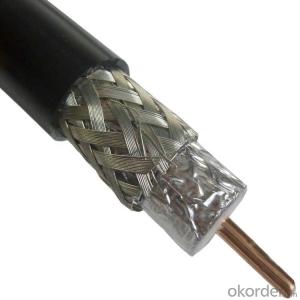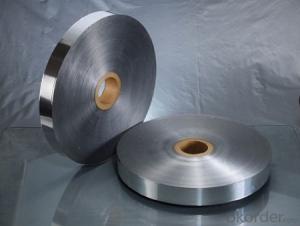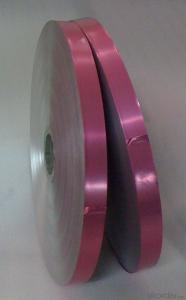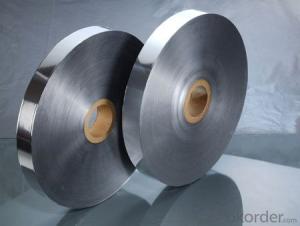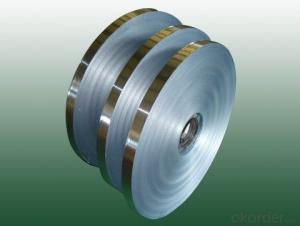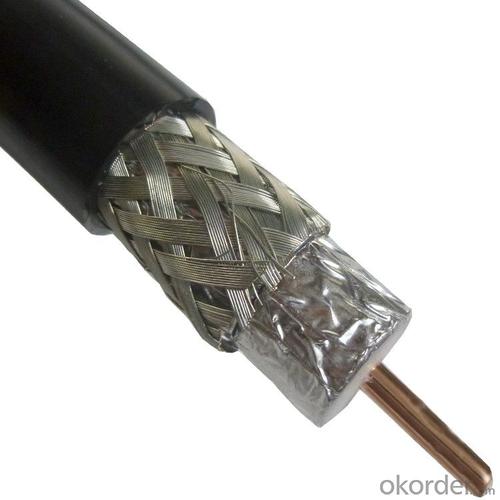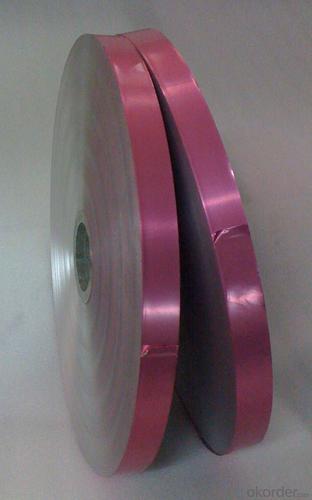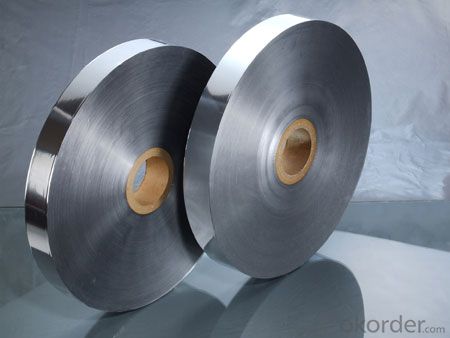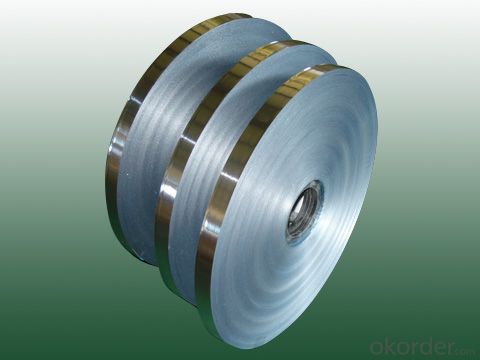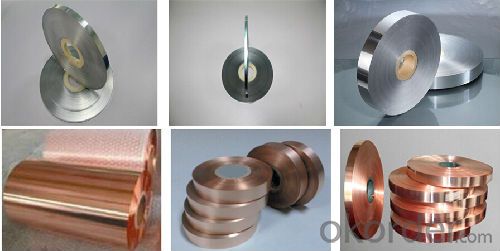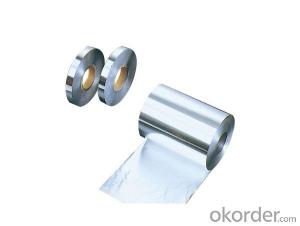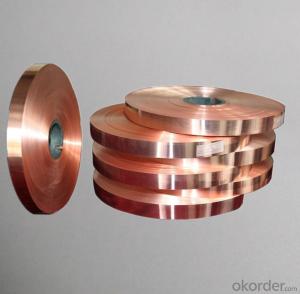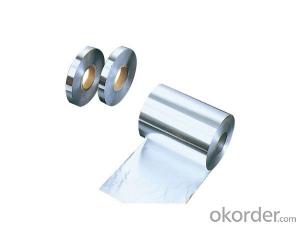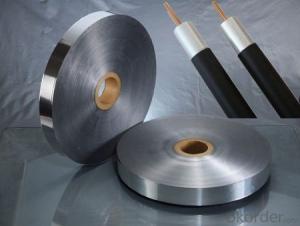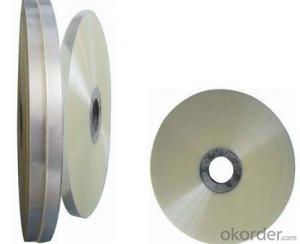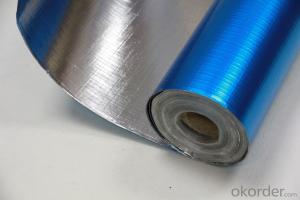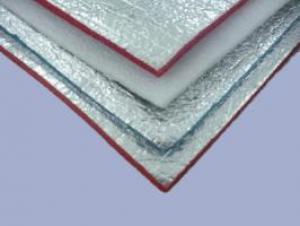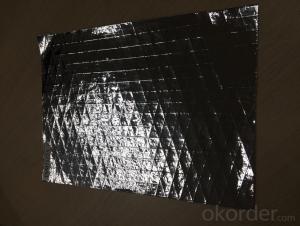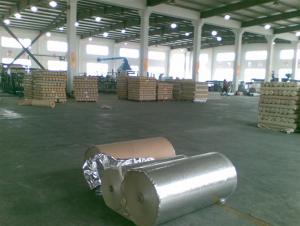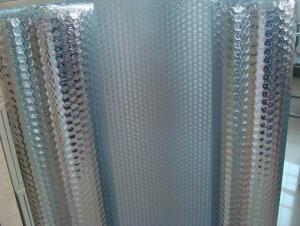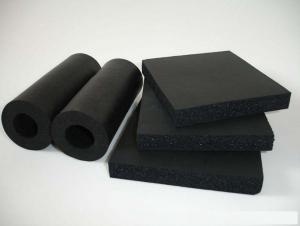Aluminum Foil Facing Shielding Copper Polyester Foil for Aluminum Foil Shielding
- Loading Port:
- Shanghai
- Payment Terms:
- TT or LC
- Min Order Qty:
- 1000 m²
- Supply Capability:
- 1000000 m²/month
OKorder Service Pledge
OKorder Financial Service
You Might Also Like
Aluminum Mylar foil Shielding Foil for Coaxial Cable communication cable
1.Structure of Aluminum Mylar foil Shielding Foil Description:
Electrical cable is used to transfer electricity, information and the realization of electromagnetic energy transformation. The electrical cable in a broad term mainly indicates to cable and in a narrow term indicate insulation material. Its definition is the aggregation of different parts below: one or more insulation cores, the wrapping layers of the cores, the general protective layers and the outer protective layers. Cables also include additive conductor without insulator.
2.Main Features of the Aluminum Mylar foil Shielding Foil:
Aluminum Mylar foil Shielding Foil is applicable to the shielding of coaxial cable, local network wire, electronic communication cable and computer peripheral wire etc.
1.Thickness: min 6.5mic; width: 300-1000mm.
2. According to GB/T 3198-2010.
3.Usages: cable shield, candy wrap
3. Aluminum Mylar foil Shielding Foil Images
4. Aluminum Mylar foil Shielding Foil Specification
AL-PET laminated foil
Description: Apply for overall or individual twisted pair shield for electronic cable and local network cables, protect from external electromagnetic interference. Features option of LUBRITAPE apply to decrease 50% friction of aluminum surface.
Construction: Aluminum foil, Polyester film
CODE | TOTAL THICKNESS | ALU THICKNESS | GLUE | POLYESTER FILM | WEIGHT |
FP007012 | 22±3 | 7 | 3 | 12 | 38.8±5% |
FP010012 | 25±3 | 10 | 3 | 12 | 46.9±5% |
FP020020 | 43±3 | 20 | 3 | 20 | 83.8±5% |
FP025012 | 40±3 | 25 | 3 | 12 | 87.6±5% |
Special specifications are also available, according to customer’s order. | |||||
AL-PET-AL laminated foil
Description: resilient shielding in cable assembling and provide the enhanced shielding required in harsh environments.
Construction: Aluminum foil +Polyester film+ Aluminum foil
CODE | TOTAL THICKNESS | ALU THICKNESS | GLUE | POLYESTER FILM | GLUE | ALU THICKNESS | WEIGHT |
DFP007015 | 35±3 | 7 | 3 | 15 | 3 | 7 | 65±5% |
DFP009020 | 39±4 | 9 | 3 | 15 | 3 | 9 | 76±5% |
DFP015025 | 61±5 | 15 | 3 | 25 | 3 | 15 | 115±5% |
DFP025025 | 80±5 | 25 | 3 | 25 | 3 | 25 | 175±5% |
Special specifications are also available, according to customer’s order. | |||||||
Bonded AL-PET laminated foil
Description: A laminated aluminum-polyester-aluminum tape is fully bonded to the foam dielectric to provide 100% coverage, longitudinally applied over the polyethylene core and the tape minimizes signal leakage.
Construction: Aluminum foil + Polyester film + Aluminum foil + EMAA film
CODE | TOTAL THICKNESS | ALU THICKNESS | GLUE | POLYESTER FILM | GLUE | ALU THICKNESS | GLUE | EMAA | WEIGHT |
DFPH009012 | 65±5 | 9 | 3 | 12 | 3 | 9 | 3 | 25 | 98±5% |
DFPH009020 | 72±5 | 9 | 3 | 20 | 3 | 9 | 3 | 25 | 108±5% |
DFPH009025 | 75±5 | 9 | 3 | 25 | 3 | 9 | 3 | 25 | 114±5% |
DFPH010025 | 84±5 | 10 | 3 | 25 | 3 | 10 | 3 | 25 | 126±5% |
Special specifications are also available, according to customer’s order. | |||||||||
Copper polyester foil
Description: Copper foil, copper lamination foil typically use as shielding for low/medium voltage cable and radio frequency coaxial cable. The rolled annealing copper foil is flexible to wrap cable core, also it has the excellent physical properties, Polyester film provides electrical insulation and high mechanical properties.
Construction: Copper foil + Polyester film
CODE | TOTAL THICKNESS | CU THICKNESS | GLUE | POLYESTER FILM | WEIGHT |
CP018012 | 33±3 | 18 | 3 | 12 | 175±10% |
CP007020 | 46±3 | 18 | 3 | 25 | 195±10% |
CP015012 | 30±3 | 15 | 3 | 12 | 160±10% |
Special specifications are also available, according to customer’s order. | |||||
5.FAQ
We have organized several common questions for our clients,may help you sincerely:
① Where you used this foil?
Aluminum Mylar foil Shielding Foil is used for cable shield, candy wrap for the shielding of coaxial cable, local network wire, electronic communication cable and computer peripheral wire etc.
②How to guarantee the quality of the products?
We have established the international advanced quality management system,every link from raw material to final product we have strict quality test;We resolutely put an end to unqualified products flowing into the market. At the same time, we will provide necessary follow-up service assurance.
③How long can we receive the product after purchase?
In the purchase of product within three working days, We will arrange the factory delivery as soon as possible. The pecific time of receiving is related to the state and position of customers.Commonly 7 to 10 working days can be served.
- Q: This question asks for a method to determine the thickness of an aluminum foil sheet.
- <p>To measure the thickness of an aluminum foil sheet, you can use a digital caliper or a micrometer. Place the foil between the jaws of the caliper and take the measurement. If you don't have these tools, you can use the 'multiple fold' method: fold the foil in half repeatedly and measure the total thickness after several folds, then divide by the number of layers to estimate the single layer thickness. For a more precise measurement, especially for thinner foils, consider using a thickness gauge designed for measuring thin materials.</p>
- Q: What precautions should be taken when handling hot food using aluminum foil as a cooking tool?
- <p>When handling hot food using aluminum foil, first ensure the foil is thick enough to withstand high temperatures without puncturing. Always use heat-resistant gloves or a thick cloth to avoid burns. Do not wrap food directly in aluminum foil if it's very hot, as this can cause the foil to tear or the food to stick. Allow the food to cool slightly before wrapping. When removing the foil from the heat source, use tongs or a spatula to avoid direct contact with the hot foil. Be cautious of steam when opening the foil, as it can be very hot.</p>
- Q: Is it safe and practical to use aluminum foil facing as a protective layer for a cutting board?
- <p>Yes, you can use aluminum foil facing as a temporary cover for a cutting board. It provides a smooth surface that can protect the cutting board from scratches and stains. However, it's not recommended for long-term use or heavy-duty cutting as it may tear or dent easily. For regular use, a proper cutting board cover or a plastic cutting mat is more durable and safer.</p>
- Q: This question asks for methods to clean aluminum foil that has excess oil on it after cooking or food storage.
- <p>To remove excess oil from aluminum foil facing after cooking or food storage, you can follow these steps: 1. Allow the foil to cool down to avoid burns. 2. Use a paper towel to blot and absorb the excess oil. 3. For stubborn oil, you can wipe the foil with a damp cloth or sponge with a mild dish soap. 4. Rinse the foil thoroughly with warm water to remove any soap residue. 5. Dry the foil with a clean towel or let it air dry. If the oil is extremely stubborn, consider using a gentle scrubber or baking soda paste to help remove it. Always check the foil for any damage or wear before reusing it.</p>
- Q: Is it safe and effective to use aluminum foil with a reflective side for baking purposes?
- <p>Yes, aluminum foil facing can be used for baking. The shiny side of aluminum foil is often used to cover baking dishes to prevent food from drying out, to create a steam effect, or to reflect heat for even cooking. However, it's important to avoid direct contact between the foil and the heating elements of the oven to prevent fire hazards. Always follow the manufacturer's guidelines for safe use and placement of aluminum foil in your oven.</p>
- Q: This question asks for a comparison of the differences among different types of plastic containers.
- <p>Plastic containers vary in material composition, durability, temperature resistance, and intended use. HDPE (High-Density Polyethylene) is sturdy and good for detergent bottles and milk jugs. LDPE (Low-Density Polyethylene) is flexible and used for plastic bags and film. PET (Polyethylene Terephthalate) is recyclable and used for water bottles and food containers. PVC (Polyvinyl Chloride) is durable but not food-safe due to potential leaching of harmful chemicals. Polypropylene is resistant to heat and acids, making it suitable for microwave-safe containers. Polystyrene is lightweight and clear but not microwave-safe and can release styrene, a harmful chemical, when heated. Each type has specific uses and properties that make it suitable or unsuitable for certain applications.</p>
- Q: Explain the distinctions between aluminum foil facing and plastic wrap, including their composition, uses, and properties.
- <p>Aluminum foil facing is a thin layer of aluminum used for insulation, moisture protection, and as a barrier to light and air. It is commonly used in construction and food packaging for its heat and cold resistance. Plastic wrap, on the other hand, is made from plastic polymers like polyethylene and is primarily used for food storage, keeping food fresh by sealing in moisture and preventing contamination. Unlike aluminum foil, plastic wrap is transparent, clingy, and does not conduct heat, making it unsuitable for cooking or insulation purposes.</p>
- Q: Is it safe to use aluminum foil facing material to wrap hot food?
- <p>Yes, aluminum foil facing can be used to wrap hot food. Aluminum foil is a common material used in cooking and food storage due to its heat resistance and ability to conduct heat evenly. It is designed to withstand high temperatures, making it suitable for wrapping and cooking food in the oven or on the grill. However, it's important to ensure that the aluminum foil is food-grade and not damaged, as this can affect the safety and quality of the food. Always follow the manufacturer's guidelines for safe use.</p>
- Q: Is it possible to use aluminum foil with a reflective side to cook pizzas or grilled cheese sandwiches?
- <p>Yes, you can use aluminum foil facing to make pizzas or grilled cheese sandwiches. The reflective side of the foil can help distribute heat evenly, which is beneficial for cooking these items evenly. However, it's important to ensure that the foil does not come into direct contact with the heating element of your oven, as it can cause a fire hazard. Always follow safety guidelines and adjust the cooking time and temperature as needed to prevent burning or melting the foil.</p>
- Q: Can aluminum foil be utilized as a surface for cooking pancakes?
- <p>While it's technically possible to cook pancakes on aluminum foil, it's not recommended. Aluminum foil can stick to the pancakes, making them difficult to flip and remove without breaking. It also conducts heat unevenly, leading to uneven cooking. Instead, use a non-stick pan or a griddle for the best results. If you must use foil, consider greasing it heavily and using a thin layer to minimize sticking and ensure even heat distribution.</p>
Send your message to us
Aluminum Foil Facing Shielding Copper Polyester Foil for Aluminum Foil Shielding
- Loading Port:
- Shanghai
- Payment Terms:
- TT or LC
- Min Order Qty:
- 1000 m²
- Supply Capability:
- 1000000 m²/month
OKorder Service Pledge
OKorder Financial Service
Similar products
Hot products
Hot Searches
Related keywords
